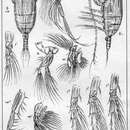en
names in breadcrumbs


Female differs from S. abyssalis:
-by proportions of the cephalothorax
-by the presence of a modified claw-shaped chaeta with an inflated (onion-shaped) base on the gnathobase of Mx1
-smaller spines on the outer edge of the 1st segment of Mxp
-the absence of spines of the third segment of the exopodite of P4.
-the supraanal plate lacks hairs
Males:
The endopodites of P5 are equal in length, their base is shorter than 0.5 of the length of the 1st segment of the exopodite of each leg.
Central Arctic Basin, North-East Pacific, North Atlantic and its Polar seas
In the North Pacific and Atlantic is found below 200m, in the Central Arctic may be found near the surface.
Female:
Cephalothorax oval shaped (egg-shaped), less than 2.4 times longer than wide. The front end is almost flat. From side view the back is slightly arched, the front 1/3 is sharply cut towarf the ventral side. 4th and 5th segments separate or partially fused, the posterior corners of the last are widely rounded. The thoracic segments lack lateral spines. Cephalothorax is about 3.5 times longer than the abdomen. The genital segment is almost as wide as long. The ventral projection of the genital segment is ¼ as thick as the next abdominal segment. Caudal rami are symmetrical, 1.5 times longer than wide, their outer edges carry a group of spines. The supraanal plate is not covered with hairs.
-A1 is longer than the body by 3-4 last segments.
-The gnathobase of Mx1 carries a modified claw-shaped chaeta with an inflated (onion-shaped) base
- The coxopodite and basopodite of P1 with rara small chaetae, the inner edge with hairs. The segments of the exopodite with long outer spines, which extend beyond the base of the next spine. The third segment of the exopodite does not carry spines on its dorsal surface. The endopodite with 2 inner chaetae.
-The second segment of the exopodite of P2 with 1 row of short spines on the back edge; the third segment carries 3 rows of spines. The second segment of the endopodite with 2 rows of spines and no outer chaeta.
-The dorsal surface of the second segment of the exopodite of P3-P4 has a proximal tow of 8-9 wide, flattened spines, and a distal row of 5-6 spines. The third segment of the exopodite of P4 does not carry spines on the dorsal surface.
Male:
Overall body shape similar to female. The front end of the body has a small medial projection, and several lateral projections. Abdomen 2 times shorter than the cephalothorax. The 2nd-4th abdominal segments are 1.5-2 times longer than wide, the 1st and 5th are much shorter. Caudal rami symmetrical and almost as long as wide.
A1 reaches the end of the fourth thoracic segment.
P5 biramous, reaches the end of the second abdominal segment. The left leg is longer than the right by the length of the distal segment, the left basipodite is much longer than the right. Endopodites are rudimentary, one-segmented, pointed, and almost identical in size. The left endopodite (including the distal chaeta) reaches the front third of the 2nd segment of the left exopodite, the right endopodite reaches the 3rd segment of the right exopodite. The inner edge of the 1st and 2nd segments of the exopodite with long hairs. The distal segments of both exopodites carry 2 apical chaetae: one short and one longer.
Female: 0,88-1,30 mm
Male: 1,00-1,40 mm